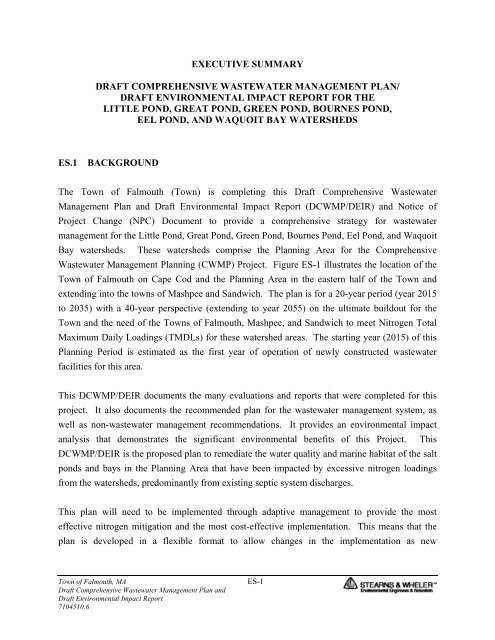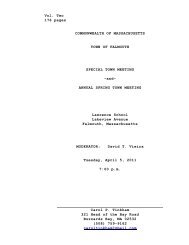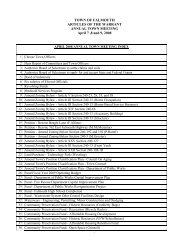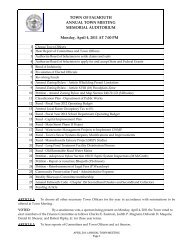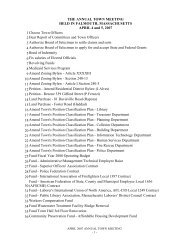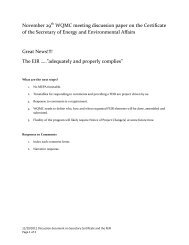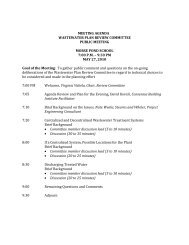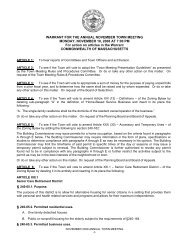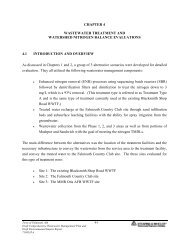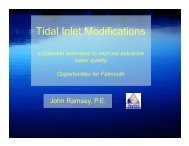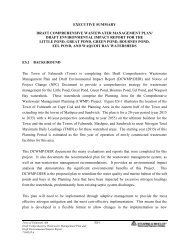EXECUTIVE SUMMARY (Without Figures) rev - Town of Falmouth
EXECUTIVE SUMMARY (Without Figures) rev - Town of Falmouth
EXECUTIVE SUMMARY (Without Figures) rev - Town of Falmouth
Create successful ePaper yourself
Turn your PDF publications into a flip-book with our unique Google optimized e-Paper software.
<strong>EXECUTIVE</strong> <strong>SUMMARY</strong><br />
DRAFT COMPREHENSIVE WASTEWATER MANAGEMENT PLAN/<br />
DRAFT ENVIRONMENTAL IMPACT REPORT FOR THE<br />
LITTLE POND, GREAT POND, GREEN POND, BOURNES POND,<br />
EEL POND, AND WAQUOIT BAY WATERSHEDS<br />
ES.1 BACKGROUND<br />
The <strong>Town</strong> <strong>of</strong> <strong>Falmouth</strong> (<strong>Town</strong>) is completing this Draft Comprehensive Wastewater<br />
Management Plan and Draft Environmental Impact Report (DCWMP/DEIR) and Notice <strong>of</strong><br />
Project Change (NPC) Document to provide a comprehensive strategy for wastewater<br />
management for the Little Pond, Great Pond, Green Pond, Bournes Pond, Eel Pond, and Waquoit<br />
Bay watersheds. These watersheds comprise the Planning Area for the Comprehensive<br />
Wastewater Management Planning (CWMP) Project. Figure ES-1 illustrates the location <strong>of</strong> the<br />
<strong>Town</strong> <strong>of</strong> <strong>Falmouth</strong> on Cape Cod and the Planning Area in the eastern half <strong>of</strong> the <strong>Town</strong> and<br />
extending into the towns <strong>of</strong> Mashpee and Sandwich. The plan is for a 20-year period (year 2015<br />
to 2035) with a 40-year perspective (extending to year 2055) on the ultimate buildout for the<br />
<strong>Town</strong> and the need <strong>of</strong> the <strong>Town</strong>s <strong>of</strong> <strong>Falmouth</strong>, Mashpee, and Sandwich to meet Nitrogen Total<br />
Maximum Daily Loadings (TMDLs) for these watershed areas. The starting year (2015) <strong>of</strong> this<br />
Planning Period is estimated as the first year <strong>of</strong> operation <strong>of</strong> newly constructed wastewater<br />
facilities for this area.<br />
This DCWMP/DEIR documents the many evaluations and reports that were completed for this<br />
project. It also documents the recommended plan for the wastewater management system, as<br />
well as non-wastewater management recommendations. It provides an environmental impact<br />
analysis that demonstrates the significant environmental benefits <strong>of</strong> this Project. This<br />
DCWMP/DEIR is the proposed plan to remediate the water quality and marine habitat <strong>of</strong> the salt<br />
ponds and bays in the Planning Area that have been impacted by excessive nitrogen loadings<br />
from the watersheds, predominantly from existing septic system discharges.<br />
This plan will need to be implemented through adaptive management to provide the most<br />
effective nitrogen mitigation and the most cost-effective implementation. This means that the<br />
plan is developed in a flexible format to allow changes in the implementation as new<br />
<strong>Town</strong> <strong>of</strong> <strong>Falmouth</strong>, MA ES-1<br />
Draft Comprehensive Wastewater Management Plan and<br />
Draft Environmental Impact Report<br />
7104510.6
technologies prove their feasibility, performance testing demonstrates the true performance <strong>of</strong><br />
the installed facilities, environmental monitoring indicates improvement in the marine water<br />
quality, and as new regulations/laws/building codes are passed to allow new approaches.<br />
There are components <strong>of</strong> this plan which need further coordination and agreement. The most<br />
significant needed component is an agreement with the Massachusetts Military Reservation<br />
(MMR) to allow <strong>Falmouth</strong> to construct a new Wastewater Treatment Facility (WWTF) on their<br />
property near the existing Otis Air Force Base (AFB) WWTF and the Regional Solid Waste<br />
Management Facility. An agreement to site a new WWTF to serve the Planning Area, and<br />
possibly the neighboring <strong>Town</strong>s <strong>of</strong> Mashpee, Sandwich, and Bourne, as well as the MMR itself,<br />
is not yet complete. Significant progress has been made toward an agreement over the past year,<br />
but additional discussions, negotiations, and agreement are needed. Discussions are also needed<br />
with Massachusetts Department <strong>of</strong> Environmental Protection (MassDEP) on the proposed<br />
treatment, recharge and water-reuse system, and the adaptive management approach proposed as<br />
part <strong>of</strong> the plan.<br />
This document is prepared for <strong>rev</strong>iew by Massachusetts Department <strong>of</strong> Environmental Protection<br />
(MassDEP) and as part <strong>of</strong> the Massachusetts Environmental Policy Act (MEPA) and Cape Cod<br />
Commission (CCC) Development <strong>of</strong> Regional Impact (DRI) joint <strong>rev</strong>iew process. A Notice <strong>of</strong><br />
Project Change (NPC) is also included in this document because detailed evaluations have been<br />
completed (and reported in this document) that were not originally scoped in the CWMP<br />
Environmental Notification Form (ENF) and ENF approval certificate.<br />
ES.2 <strong>SUMMARY</strong> OF WASTEWATER PROBLEMS AND NEEDS IN THE<br />
PLANNING AREA<br />
The identification and understanding <strong>of</strong> the wastewater related problems in the Planning Area<br />
has been a long process.<br />
The first recommendation <strong>of</strong> sewer extensions to portions <strong>of</strong> the Planning Area date back to May<br />
1981 in the Wastewater Facilities Plan by CDM and the Environmental Impact Report by<br />
USEPA. That plan recommended sewering the densely developed Maravista Peninsula located<br />
between Little and Great Ponds, as well as the <strong>Falmouth</strong> Heights area located west <strong>of</strong> Little<br />
Pond. That sewer extension was planned to be the second phase <strong>of</strong> the larger wastewater project<br />
<strong>Town</strong> <strong>of</strong> <strong>Falmouth</strong>, MA ES-2<br />
Draft Comprehensive Wastewater Management Plan and<br />
Draft Environmental Impact Report<br />
7104510.6
that constructed the original Blacksmith Shop Road WWTF, connected the Woods Hole sewer<br />
system to the Blacksmith Shop Road facility, eliminated the Woods Hole ocean outfall, and<br />
provided sewer extension to Main Street, Inner Harbor, and <strong>Falmouth</strong> Beach areas <strong>of</strong> <strong>Falmouth</strong><br />
Center. The second phase <strong>of</strong> that project was never completed due to problems with the original<br />
Blacksmith Shop Road WWTF.<br />
The second recommendation <strong>of</strong> sewer extensions to portions <strong>of</strong> the Planning Area dates to<br />
January 2001 in the Wastewater Facilities Plan and Environmental Impact Report by Stearns &<br />
Wheler. That plan identified that excessive nitrogen loadings to the watersheds <strong>of</strong> Little Pond<br />
and Great Pond were impacting water quality to the two salt ponds and that sewer extension was<br />
the best solution. That plan indicated that the nitrogen limits for the two ponds were needed<br />
before sewer extension planning could proceed further. That plan also recommended an upgrade<br />
and expansion <strong>of</strong> the Blacksmith Shop Road WWTF (completed in 2005), sewer connection to<br />
the <strong>Falmouth</strong> High School (completed in 2007 - 2008), sewer extension to the North Davis<br />
Straits Planning Area (<strong>Falmouth</strong> Mall and surrounding area), sewer extension to the Scranton<br />
Avenue Area, and sewer extension to the West <strong>Falmouth</strong> Harbor area. These last three sewer<br />
extensions have not yet been completed and it is noted that the North Davis Straits area is within<br />
the Planning Area for the current project. This DCWMP/DEIR includes the implementation<br />
timeline <strong>of</strong> these three p<strong>rev</strong>iously approved sewer extensions coordinated with the<br />
implementation timeline <strong>of</strong> the wastewater facilities for the Planning Area.<br />
The third recommendation <strong>of</strong> sewer extensions for portions <strong>of</strong> the Planning Area dates to March<br />
2001 with the completion <strong>of</strong> the Ashumet Plume Nitrogen Offset Program Detailed Analysis <strong>of</strong><br />
Feasible Corrective Actions by the team <strong>of</strong> Horsley & Witten, Inc.; UMass School <strong>of</strong> Marine<br />
Science and Technology (SMAST); and Applied Coastal Research and Engineering, Inc. This<br />
recommendation did not proceed (in part) due to the need for Nitrogen Total Maximum Daily<br />
Load (TMDL) limits for the salt ponds.<br />
The nitrogen TMDLs developed by the Massachusetts Estuaries Project (MEP) and promulgated<br />
by the Environmental Protection Agency since 2001 documented the following problems in the<br />
salt ponds <strong>of</strong> the Planning Area:<br />
High concentration <strong>of</strong> nitrogen in the marine water that has led to excessive algae<br />
production and eutrophic conditions.<br />
<strong>Town</strong> <strong>of</strong> <strong>Falmouth</strong>, MA ES-3<br />
Draft Comprehensive Wastewater Management Plan and<br />
Draft Environmental Impact Report<br />
7104510.6
Loss <strong>of</strong> water clarity from the suspended algae which has led to loss <strong>of</strong> rooted eel grass<br />
on the floor <strong>of</strong> the estuaries.<br />
Deposition <strong>of</strong> algae in the estuaries which has further damaged eel grass beds, smothered<br />
shellfish resources, and depleted dissolved oxygen concentrations in the estuary and<br />
severely impacted the benthic communities on the estuarine floor.<br />
These TMDLs identified threshold nitrogen concentrations for these salt ponds and calculated<br />
the amount <strong>of</strong> existing wastewater nitrogen that would need to be removed to meet the threshold<br />
concentrations. The percentages <strong>of</strong> existing wastewater nitrogen loading (from existing septic<br />
systems) that needs to be removed to meet the nitrogen TMDLs is illustrated on Figure ES-2.<br />
This figure also illustrates the existing areas <strong>of</strong> <strong>Town</strong> served by sewers and the three potential<br />
wastewater treatment plant sites evaluated as part <strong>of</strong> this project. It is noted that the TMDLs<br />
have been completed for all coastal ponds in the Planning Area except for the western portion <strong>of</strong><br />
Waquoit Bay (“Waquoit West”). TMDL completion for Waquoit West is expected in 2010 or<br />
2011. In an effort to proceed with the wastewater planning for the total Planning Area, Stearns<br />
& Wheler used the existing wastewater nitrogen removal percentages from the adjacent Bournes<br />
Pond watershed as a planning assumption <strong>of</strong> the removals needed for Waquoit West.<br />
The wastewater removals shown on Figure ES-2 are for the “existing conditions” in the<br />
approximate time period <strong>of</strong> 2003 to 2004 as documented by the Massachusetts Estuaries Project.<br />
Additional land use growth has occurred and is expected in this area, and when the ultimate<br />
buildout is projected for this area, the needed wastewater nitrogen removals are even greater.<br />
Figure ES-3 illustrates the percentage <strong>of</strong> future wastewater nitrogen loadings that need to be<br />
removed to meet the nitrogen limits. These are very stringent limits that can only be met by<br />
sewering the majority <strong>of</strong> the Planning Area, advanced wastewater treatment, and careful recharge<br />
in selected locations <strong>of</strong> the Planning Area that can accommodate the return flow and remaining<br />
nitrogen estimated at 1 to 3 mg/L total nitrogen. This figure also illustrates planned and<br />
proposed sewer areas <strong>Town</strong>-wide. The green area is the portion <strong>of</strong> the Planning Area (Phase 1<br />
and 2 areas) proposed for sewering in the first 20 year period.<br />
The large scale wastewater collection treatment and recharge project required to meet these<br />
TMDLs presents a significant challenge to the <strong>Town</strong> and will be a large expense to the <strong>Town</strong> and<br />
its residents. In meeting this challenge and implementing this project the <strong>Town</strong> will be executing<br />
<strong>Town</strong> <strong>of</strong> <strong>Falmouth</strong>, MA ES-4<br />
Draft Comprehensive Wastewater Management Plan and<br />
Draft Environmental Impact Report<br />
7104510.6
the Wastewater and Nutrient Management Vision articulated by the Selectmen: “By<br />
comprehensively and effectively managing its wastewater and other nutrient sources, <strong>Falmouth</strong><br />
will improve water quality, protect public health and enhance the town’s economic vitality.<br />
<strong>Falmouth</strong> will <strong>of</strong>fer its residents, visitors and future generations healthy waters in order to sustain<br />
the town’s property values and vibrant economy.”<br />
The <strong>Town</strong>’s wastewater management needs were summarized in the October 2007 Needs<br />
Assessment Report, which is available at the <strong>Town</strong>’s Wastewater Projects website<br />
(www.falmouthwastewaterprojects.org), the <strong>Town</strong> Wastewater Department web page at<br />
www.falmouthmass.us, as well as in the <strong>Town</strong>’s 5 libraries.<br />
ES.3 <strong>SUMMARY</strong> OF IDENTIFICATION AND SCREENING OF ALTERNATIVE<br />
SOLUTIONS TO MEET THESE WASTEWATER NEEDS<br />
Many alternative solutions were identified, researched, and screened (eliminated or retained for<br />
more evaluation and cost development) in the Alternatives Screening Analysis Report,<br />
November 2009, which is also available at the <strong>Town</strong>’s wastewater projects website<br />
(www.falmouthwastewaterprojects.org), the <strong>Town</strong> Wastewater Department web page at<br />
www.falmouthmass.us, as well as in the <strong>Town</strong>’s 5 libraries. The following list summarizes<br />
many <strong>of</strong> the alternative solutions researched:<br />
1. Centralized municipal wastewater treatment facilities and sites, including:<br />
a. Small package (community) treatment facilities incorporating biological<br />
nitrogen removal (BNR) with designed average performance <strong>of</strong> approximately<br />
6 mg/L total nitrogen.<br />
b. Centralized treatment technologies incorporating enhanced nitrogen removal<br />
(ENR) with designed average performance <strong>of</strong> approximately 3 mg/L total nitrogen.<br />
c. Technologies to achieve less than 3 mg/L total nitrogen on average.<br />
d. Technologies to remove endocrine disruptors and the “emerging contaminants”<br />
<strong>of</strong> personal-care products and pharmaceuticals.<br />
<strong>Town</strong> <strong>of</strong> <strong>Falmouth</strong>, MA ES-5<br />
Draft Comprehensive Wastewater Management Plan and<br />
Draft Environmental Impact Report<br />
7104510.6
e. Treatment alternatives for phosphorus.<br />
f. Disinfection alternatives.<br />
g. Residuals management.<br />
h. Treatment plant sites and treated-water recharge sites.<br />
i. Treated-water recharge technologies:<br />
sand infiltration beds<br />
subsurface infiltration<br />
spray irrigation<br />
well injection<br />
wick well technology<br />
drip irrigation<br />
j. Ocean outfall disposal.<br />
k. Collection system technologies:<br />
gravity sewers, lift stations, and force mains<br />
low pressure sewers with grinder pumps<br />
septic tank effluent sewers (pressure and gravity)<br />
combination <strong>of</strong> technologies<br />
2. Decentralized wastewater treatment systems:<br />
a. Individual on-site wastewater treatment and disposal technologies, including: 1<br />
1 MassDEP approval status is referenced to the 2007 date <strong>of</strong> the Alternatives Screening Analysis Report.<br />
<strong>Town</strong> <strong>of</strong> <strong>Falmouth</strong>, MA ES-6<br />
Draft Comprehensive Wastewater Management Plan and<br />
Draft Environmental Impact Report<br />
7104510.6
1) Systems with MassDEP approval for general use, but not credited for<br />
nitrogen removal:<br />
Title 5 septic systems<br />
JET aerobic systems<br />
Orenco intermittent sand filter<br />
2) Non-discharge and/or reduced-discharge systems:<br />
Tight tanks<br />
Waterless Toilets (Composting/Incinerating)<br />
Urine source separating toilets<br />
3) Systems approved for general use in nitrogen-sensitive areas:<br />
Recirculating sand filters<br />
RUCK ® system<br />
4) Systems approved for provisional use in nitrogen-sensitive areas:<br />
Bioclere systems<br />
FAST systems<br />
Waterloo Bi<strong>of</strong>ilter systems<br />
Amphidrome systems<br />
AdvanTex systems<br />
NITREX ® systems<br />
5) Systems approved for pilot use in nitrogen-sensitive areas:<br />
SeptiTech systems<br />
<strong>Town</strong> <strong>of</strong> <strong>Falmouth</strong>, MA ES-7<br />
Draft Comprehensive Wastewater Management Plan and<br />
Draft Environmental Impact Report<br />
7104510.6
Norweco Singulair systems<br />
RUCK ® CFT<br />
Cromaglass WWT systems<br />
NITREX ® -Plus<br />
Bio Barrier Membrane Bio-Reactor<br />
Omni recirculating sand filter system<br />
3. Flow and loading reduction alternatives:<br />
Infiltration and Inflow (I/I) reduction 2<br />
Reduction <strong>of</strong> household water consumption.<br />
Pricing policy for water and wastewater service.<br />
Wastewater reuse and recycling.<br />
Reduction <strong>of</strong> wastewater loadings.<br />
Waterless toilets.<br />
Growth management regulation.<br />
4. Additional non-wastewater nitrogen mitigation alternatives:<br />
Reduction <strong>of</strong> nitrogen from fertilizers and pet wastes.<br />
Watershed modifications and constructed wetlands for nitrogen attenuation.<br />
Stormwater management and treatment.<br />
Pond inlet modifications to provide improved tidal flushing.<br />
Modified zoning or sewer use regulation.<br />
Nitrate barrier wall considerations.<br />
2<br />
This is for the existing wastewater collection system outside <strong>of</strong> the Planning Area pertaining mainly to the older<br />
Woods Hole collection system.<br />
<strong>Town</strong> <strong>of</strong> <strong>Falmouth</strong>, MA ES-8<br />
Draft Comprehensive Wastewater Management Plan and<br />
Draft Environmental Impact Report<br />
7104510.6
These alternatives were evaluated for feasibility, effectiveness, and other criteria, and from all <strong>of</strong><br />
these potential solutions, the following ones were identified to be evaluated in detail:<br />
1. Sewer extension to the Planning Area to collect the current and future septic system<br />
nitrogen loadings that are causing the problems.<br />
2. Advanced treatment (Enhanced Nitrogen Removal or ENR) with Sequencing Batch<br />
Reactor (SBR) technology followed by polishing filters (Treatment Scenario “A”) at one <strong>of</strong><br />
the following alternative treatment sites:<br />
Existing Blacksmith Shop Road WWTF site (Alternative 1A)<br />
<strong>Falmouth</strong> Country Club site (Alternative 2A)<br />
MMR/Otis WWTF site (Alternative 3A)<br />
3. Possible additional treatment to further reduce nitrogen and treat for the emerging<br />
contaminants <strong>of</strong> endocrine disruptors, pharmaceuticals, and personal care products.<br />
4. Treated water recharge at the <strong>Falmouth</strong> Country Club site.<br />
5. Improved lawn fertilizer management practices.<br />
6. Improved stormwater management.<br />
7. Pond inlet widening at selected ponds to increase tidal flushing, thereby potentially<br />
reducing the amount <strong>of</strong> upper watershed nitrogen removal required.<br />
8. Possible watershed modifications (freshwater wetland and pond improvements and/or<br />
restorations) to increase the amount <strong>of</strong> nitrogen that is naturally attenuated in the<br />
watershed.<br />
The main findings <strong>of</strong> the Needs Assessment Report and the Alternatives Screening Analysis<br />
Report, as well as the alternatives selected for detailed evaluation, were summarized in the<br />
December 2007 Environmental Notification Form (ENF) document and submitted to initiate the<br />
<strong>Town</strong> <strong>of</strong> <strong>Falmouth</strong>, MA ES-9<br />
Draft Comprehensive Wastewater Management Plan and<br />
Draft Environmental Impact Report<br />
7104510.6
environmental <strong>rev</strong>iew <strong>of</strong> this project. The ENF <strong>rev</strong>iew included a public hearing and site visit<br />
(bus tour <strong>of</strong> the Planning Area and the potential wastewater facility sites). Final comments were<br />
received and are attached in an appendix in this DCWMP/DEIR.<br />
ES.4 <strong>SUMMARY</strong> OF DETAILED EVALUATIONS TO REMEDIATE THE<br />
WASTEWATER PROBLEMS<br />
A. Initial Alternatives Evaluation. The alternatives selected for detailed evaluation (as<br />
discussed above) were evaluated in detail with cost development and the following findings are<br />
noted:<br />
1. The costs for the three alternatives were similar (within 8 percent <strong>of</strong> one another) due<br />
to the large wastewater collection component (sewers and pump stations) that is common to<br />
all. The costs for these alternatives are summarized later in this Executive Summary<br />
section.<br />
2. The MMR/Otis AFB WWTF site was the best site for the following reasons:<br />
It has the most space for a modern expandable treatment facility.<br />
It is located in the Planning Area.<br />
It does not have any abutting residential neighborhoods; therefore, “Not in my<br />
Back Yard” (NIMBY) opposition to this site would be the least <strong>of</strong> the three sites.<br />
It lends itself to becoming a regional facility also serving the towns <strong>of</strong> Mashpee,<br />
Sandwich, and Bourne as well as the MMR; and is consistent with Cape Cod<br />
Commission efforts to encourage regionalization where feasible.<br />
3. The <strong>Falmouth</strong> Country Club site has good infiltration capacity and could recharge a<br />
large flow <strong>of</strong> treated water; however, even with nitrogen removal to 3 mg/L and sewering<br />
up to 100% <strong>of</strong> the watersheds, the return <strong>of</strong> a large volume <strong>of</strong> treated water to the<br />
watersheds for recharge means that not all <strong>of</strong> the TMDLs can be met with infiltration at the<br />
<strong>Falmouth</strong> Country Club site as evaluated. These alternatives involving ENR treatment and<br />
recharge at the <strong>Falmouth</strong> Country Club site (Alternatives 1A, 2A and 3A) would meet the<br />
<strong>Town</strong> <strong>of</strong> <strong>Falmouth</strong>, MA ES-10<br />
Draft Comprehensive Wastewater Management Plan and<br />
Draft Environmental Impact Report<br />
7104510.6
TMDLs for Little, Great, and Green Ponds. However, these alternatives would not meet<br />
the TMDL for Bournes Pond or the estimated TMDL for Waquoit West, even with 100%<br />
sewering <strong>of</strong> those watersheds, and even with a Bournes Pond inlet widening.<br />
4. Infiltration at the <strong>Falmouth</strong> Country Club site would require a large portion <strong>of</strong><br />
forested area to be cleared to construct the infiltration facilities, and less intrusive recharge<br />
technologies are desired.<br />
5. The vast majority <strong>of</strong> each watershed (100% <strong>of</strong> some watersheds) needs to be sewered<br />
and the wastewater needs to be treated to levels below 3 mg/L total nitrogen and the treated<br />
wastewater needs to be recharged fairly evenly across the Planning Area in order to meet<br />
TMDLs for all ponds in the planning area.<br />
6. Given the level <strong>of</strong> treatment required to meet TMDLs, there was a desire to recharge<br />
the treated water in such a way that it could be reused to recharge ponds, streams, wetlands,<br />
and drinking water supplies.<br />
7. Improved lawn fertilizer management should build on the successful work <strong>of</strong> the<br />
<strong>Falmouth</strong> Friendly Lawns Program and be promoted and managed by Barnstable County<br />
because these problems are common to all Cape towns.<br />
8. The <strong>Town</strong> has an ongoing stormwater management program managed by the <strong>Town</strong>’s<br />
Engineering Division. This program needs expanded funding to address the many<br />
stormwater mitigation needs.<br />
9. The openings to Little Pond and Bournes Pond could be enlarged to provide<br />
improved tidal flushing and to reduce wastewater nitrogen removal requirements.<br />
Additional evaluation is needed to evaluate environmental impacts and overall feasibility.<br />
10. Watershed modifications are recommended for the Coonamessett River, and the<br />
Coonamessett River Restoration Committee moved forward with the recommendation.<br />
B. Additional Evaluations for Water Reuse and Well Recharge in the Planning Area.<br />
Additional wastewater management evaluations were completed to increase the treatment level<br />
<strong>Town</strong> <strong>of</strong> <strong>Falmouth</strong>, MA ES-11<br />
Draft Comprehensive Wastewater Management Plan and<br />
Draft Environmental Impact Report<br />
7104510.6
and distribute the treated water over a greater area so that all the nitrogen TMDLs can be met, to<br />
reduce the area <strong>of</strong> environmental impact for recharge, and to allow reuse for recharge <strong>of</strong> ponds,<br />
streams, wetlands, and drinking water supplies. The following two treatment technologies were<br />
evaluated to meet Massachusetts’ highest standards for treated water reuse and recharge into<br />
Zone II areas:<br />
Membrane Bioreactors (MBR) followed by granular activated carbon (GAC) adsorption<br />
treatment (Treatment Scenario B).<br />
MBRs followed by <strong>rev</strong>erse osmosis (RO) water purification and carbon adsorption<br />
treatment (Treatment Scenario C).<br />
In addition to achieving lower total nitrogen concentrations, these process combinations would<br />
be designed to remove endocrine disruptors, personal care products, and pharmaceuticals in the<br />
water. Trace amounts <strong>of</strong> these components are now being detected in wastewaters and water<br />
supplies due to their increased use and the development <strong>of</strong> more precise analytical methods.<br />
These components are called “emerging contaminants” because they are being detected at low<br />
levels but no threshold limits for human or environmental health have yet been developed.<br />
MassDEP recently (early 2009) developed a total organic carbon (TOC) limit <strong>of</strong> 3 mg/L for<br />
recharges into a Zone II area with groundwater flow times <strong>of</strong> greater than two years. The TOC<br />
parameter is a surrogate for the many emerging contaminants that may be in the water; and<br />
MassDEP research has indicated that treated water with TOC values less than 3 mg/L also have<br />
very low (or non-detectable) levels <strong>of</strong> the emerging contaminants. MassDEP also developed a<br />
TOC limit <strong>of</strong> 1 mg/L for recharges into a Zone II area with groundwater flow times <strong>of</strong> greater<br />
than 2 years that do not have the benefit <strong>of</strong> treatment in the unsaturated soil zone (i.e, for direct<br />
recharge to the groundwater system). MassDEP does allow some modifications to these limits<br />
for specific circumstances after discussions/negotiations with MassDEP.<br />
This evaluation also included infiltration <strong>of</strong> the treated water to the groundwater system through<br />
a series <strong>of</strong> recharge wells located in the Route 151 right-<strong>of</strong>-way. The recharge wells require little<br />
land disturbance, but must have highly purified water to avoid “soil plugging” at the well screen<br />
and subsequent reduction <strong>of</strong> infiltration capacity. Treatment Scenario C can produce a treated<br />
water suitable for well recharge as demonstrated at existing municipal installations. Treatment<br />
Scenario B is a lower cost treatment technology that is believed to be suitable for well recharge.<br />
<strong>Town</strong> <strong>of</strong> <strong>Falmouth</strong>, MA ES-12<br />
Draft Comprehensive Wastewater Management Plan and<br />
Draft Environmental Impact Report<br />
7104510.6
Additional performance testing <strong>of</strong> this treatment combination (Treatment Scenario B) would be<br />
required during implementation to prove its long-term ability to be compatible with well<br />
recharge. If the performance is not satisfactory, then <strong>rev</strong>erse osmosis would need to be added to<br />
the process (Treatment Scenario C).<br />
The evaluation <strong>of</strong> recharge wells was not originally scoped as part <strong>of</strong> the December 2007<br />
Environmental Notification Form (ENF) for this project due to concerns about regulatory<br />
acceptance. Evaluation <strong>of</strong> this recharge technology was added to the scope for a number <strong>of</strong><br />
reasons including: 1) the desire to take advantage <strong>of</strong> the very high level <strong>of</strong> treatment required to<br />
meet the TMDLs to then provide water reuse within the planning area watersheds, i.e., recharge<br />
upgradient <strong>of</strong> surface water bodies and drinking water supplies, and 2) the desire to reduce the<br />
footprint (and therefore the environmental impact <strong>of</strong> construction) needed for recharge. The<br />
addition <strong>of</strong> these evaluations is discussed in the Notice <strong>of</strong> Project Change included in this<br />
document.<br />
The costs for these reuse and well recharge alternatives are summarized later in this Executive<br />
Summary section.<br />
C. Additional Evaluations to Investigate the Feasibility and Costs <strong>of</strong> Developing an<br />
Ocean Outfall. P<strong>rev</strong>ious wastewater planning efforts in the late 1970s and early 1980s<br />
evaluated the possible use <strong>of</strong> an ocean outfall from Nobska Point in Woods Hole extending<br />
approximately 2,000 feet into Vineyard Sound. <strong>Town</strong> Meeting decisions at that time did not<br />
approve it. Since then, the Massachusetts Ocean Sanctuaries Act was passed which prohibits the<br />
discharge <strong>of</strong> any municipal treated water into this portion <strong>of</strong> Vineyard Sound (as well as all <strong>of</strong><br />
the marine waters around <strong>Falmouth</strong>). The legislation is strictly imposed and a variance would<br />
require action by several State agencies. It is believed that a variance would only be given if it<br />
was shown that ocean disposal was the only feasible way to protect public health and the<br />
environment. Due to this law, preliminary evaluations for this disposal technology in the<br />
November 2007 Alternatives Screening Analysis Report for this project deemed that an ocean<br />
outfall would be infeasible.<br />
After issuance <strong>of</strong> the Alternatives Screening Analysis Report and the December 2007<br />
Environmental Notification Form, several community members requested the evaluation <strong>of</strong> this<br />
<strong>Town</strong> <strong>of</strong> <strong>Falmouth</strong>, MA ES-13<br />
Draft Comprehensive Wastewater Management Plan and<br />
Draft Environmental Impact Report<br />
7104510.6
option in more detail due to the high cost <strong>of</strong> the p<strong>rev</strong>iously described treatment and<br />
recharge/reuse scenarios and because it may provide reduced environmental impact.<br />
An ocean outfall treatment and discharge alternative (Scenario 1D) would have the following<br />
components:<br />
Wastewater collection from the Planning Area to meet the nitrogen TMDL as indicated in<br />
Figure ES-3.<br />
Conveyance to the existing Blacksmith Shop Road WWTF or MMR and treatment to the<br />
current standards (advanced nitrogen and solids removal) followed by filtration and<br />
disinfection.<br />
Potential discontinuance <strong>of</strong> the current groundwater recharge at the existing WWTF site<br />
and conveyance <strong>of</strong> the total flow (from existing sewered area and needed sewered area in<br />
the Planning Area) to an additional disinfection facility in Woods Hole.<br />
Final disinfection and discharge through the outfall.<br />
Costs for the ocean outfall discharge scenario at Woods Hole are summarized at the end <strong>of</strong> this<br />
section.<br />
Evaluation <strong>of</strong> the non-monetary factors indicates the following findings:<br />
An ocean outfall would entirely remove wastewater nitrogen (and other constituents)<br />
from the watersheds to the sensitive coastal ponds. By eliminating recharge <strong>of</strong> treated<br />
wastewater to the watersheds, the outfall option would reduce the amount <strong>of</strong> upper<br />
watershed sewering required to meet the TMDLs.<br />
An outfall at this location could have an environmental benefit because it would move the<br />
treated water (with its low nitrogen concentration <strong>of</strong> less than 3 mg/L total nitrogen)<br />
beyond the near-shore environment into a well mixed zone. It is noted that groundwater<br />
recharge <strong>of</strong> treated water eventually reaches the same <strong>of</strong>f-shore environment; but in doing<br />
so, it moves through the near-shore environment where it causes eutrophication in the<br />
estuaries.<br />
<strong>Town</strong> <strong>of</strong> <strong>Falmouth</strong>, MA ES-14<br />
Draft Comprehensive Wastewater Management Plan and<br />
Draft Environmental Impact Report<br />
7104510.6
An outfall at this location with water treated to ENR standards would most likely not<br />
have an adverse environmental impact on the marine environment, but additional<br />
scientific studies would be needed to address questions and concerns <strong>of</strong> the local,<br />
regional, state, and federal stakeholders that would need to approve it.<br />
The outfall would lower groundwater elevations <strong>of</strong> the Sagamore flow lens in certain<br />
areas <strong>of</strong> <strong>Town</strong> due to the relocation <strong>of</strong> the current water recharges (at the existing WWTF<br />
and at existing septic systems) to the outfall discharge. This effect would need to be<br />
evaluated in detail using a groundwater model for the whole Sagamore flow lens.<br />
These scientific studies would take at least 1 year to complete, and the public and<br />
regulatory decision process on a CWMP and a variance request for an ocean outfall in an<br />
ocean sanctuary could add five more years.<br />
Legal challenges could add additional delays.<br />
A detailed list <strong>of</strong> the scientific studies, regulatory permits, and approvals needed for this scenario<br />
to proceed is included in the body <strong>of</strong> this report.<br />
Although not evaluated for costs, a discharge to Cape Cod Canal with tertiary treatment at the<br />
MMR may also be a feasible alternative and should be considered in any future scoping<br />
processes. P<strong>rev</strong>ious environmental studies have shown that the Canal has a tremendous amount<br />
<strong>of</strong> mixing and dilution, and outfalls to the canal have been evaluated at least two times in the<br />
past.<br />
D. Summary <strong>of</strong> Costs for Wastewater Management Scenarios. The following Table ES-1<br />
summarizes current (July 2009 Benchmark) costs <strong>of</strong> the main wastewater management scenarios<br />
evaluated for the 20-year planning period <strong>of</strong> 2015 to 2035 to extend sewers to the Phase 1 and 2<br />
areas as illustrated on Figure ES-3. These costs are detailed in the main body <strong>of</strong> this report.<br />
<strong>Town</strong> <strong>of</strong> <strong>Falmouth</strong>, MA ES-15<br />
Draft Comprehensive Wastewater Management Plan and<br />
Draft Environmental Impact Report<br />
7104510.6
TABLE ES-1<br />
<strong>SUMMARY</strong> OF COSTS (1) FOR ALTERNATIVE<br />
WASTEWATER MANAGEMENT SCENARIOS FOR<br />
20-YEAR PLANNING PERIOD FROM 2015 TO 2035 FOR<br />
SEWER EXTENSION AND WASTEWATER MANAGEMENT FOR PHASE 1 AND 2 AREAS<br />
SCENARIO NUMBER AND DESCRIPTION<br />
1A Wastewater Collection, ENR (2) treatment at Blacksmith<br />
Shop Road (BSR (3) ) site, and recharge at <strong>Falmouth</strong> Country<br />
Club (FCC) site.<br />
2A Wastewater collection, ENR (2) treatment at FCC site, and<br />
recharge at FCC (4) site.<br />
3A Wastewater collection, ENR (2) treatment at MMR (5) site,<br />
and recharge at FCC (4) site.<br />
3B Wastewater collection, MBR (6) and GAC (7) treatment at the<br />
MMR site and well recharge at Route 151 ROW (8) (10) .<br />
3C Wastewater collection, MBR (6) and RO (9) and GAC (7)<br />
treatment at the MMR site and well recharge at Route 151<br />
ROW (8) (10) .<br />
1D Wastewater collection, ENR (2) treatment at BSR (3) site and<br />
ocean outfall disposal at Nobska Point.<br />
Notes:<br />
TOTAL<br />
CAPITAL<br />
COSTS (1)<br />
($ MILLION)<br />
ANNUAL O&M<br />
COSTS (1)<br />
($ MILLION)<br />
380 2.9<br />
350 2.9<br />
370 3.2<br />
400 5.3<br />
410 6.3<br />
410 2.9<br />
(1) All costs are in millions <strong>of</strong> dollars rounded to two significant digits with the following definitions:<br />
Costs are referred to July 2009; therefore, these costs will need to be scaled to account for inflation in the<br />
future.<br />
Total capital costs include estimated construction costs, 25 percent contingency allowance, and 25 percent<br />
allowance for fiscal, legal, and engineering costs <strong>of</strong> implementation.<br />
Annual operation and maintenance (O&M) cost includes annual costs for electricity, chemicals, solids<br />
disposal/reuse, operating labor, equipment repair and maintenance, and environmental monitoring.<br />
(2) Enhanced Nitrogen Removal (ENR).<br />
(3)<br />
Blacksmith Shop Road (BSR).<br />
(4)<br />
<strong>Falmouth</strong> Country Club (FCC).<br />
(5)<br />
Massachusetts Military Reservation (MMR).<br />
(6)<br />
Membrane Bioreactor (MBR).<br />
(7)<br />
Granular Activated Carbon (GAC).<br />
(8)<br />
Right-<strong>of</strong>-Way (ROW).<br />
(9)<br />
Reverse Osmosis (RO).<br />
(10)<br />
Alternatives 3B and 3C are the Reuse Alternatives due to their use <strong>of</strong> advanced treatment that meets reuse<br />
requirements.<br />
<strong>Town</strong> <strong>of</strong> <strong>Falmouth</strong>, MA<br />
Draft Comprehensive Wastewater Management Plan and<br />
Draft Environmental Impact Report<br />
7104510.6<br />
ES-16
The next table (Table ES-2) summarizes costs to meet the nitrogen TMDLs in the 40-year period<br />
<strong>of</strong> 2015 to 2055 with projected wastewater infrastructure. These costs are provided as a<br />
benchmark because adaptive management techniques and experience during the first 20 years<br />
(2015 to 2035) are expected to reduce the need for this full level <strong>of</strong> wastewater treatment and<br />
reuse.<br />
TABLE ES-2<br />
<strong>SUMMARY</strong> OF COSTS (1) FOR ALTERNATIVE<br />
WASTEWATER MANAGEMENT SCENARIOS FOR<br />
40-YEAR TIME PERIOD FROM 2015 TO 2055 FOR<br />
SEWER EXTENSION AND WASTEWATER MANAGEMENT FOR PHASE 1, 2, AND 3 AREAS<br />
SCENARIO NUMBER AND DESCRIPTION<br />
1A Wastewater Collection, ENR (2) treatment at Blacksmith Shop<br />
Road (BSR (3) ) site, and recharge at <strong>Falmouth</strong> Country Club<br />
(FCC) site.<br />
2A Wastewater collection, ENR (2) treatment at FCC site, and<br />
recharge at FCC (4) site.<br />
3A Wastewater collection, ENR (2) treatment at MMR (5) site, and<br />
recharge at FCC (4) site.<br />
3B Wastewater collection, MBR (6) and GAC (7) treatment at the MMR<br />
site and well recharge at Route 151 ROW (8) (10) .<br />
3C Wastewater collection, MBR (6) and RO (9) and GAC (7) treatment at<br />
the MMR site and well recharge at Route 151 ROW (8) (10) .<br />
1D Wastewater collection, ENR (2) treatment at BSR (3) site and ocean<br />
outfall disposal at Nobska Point.<br />
TOTAL<br />
CAPITAL<br />
COSTS (1)<br />
($ MILLION)<br />
ANNUAL<br />
O&M<br />
COSTS (1)<br />
($ MILLION)<br />
NA (10) NA (10)<br />
NA (11) NA (11)<br />
NA (11) NA (11)<br />
600 7.6<br />
610 9.4<br />
590 4.4<br />
Notes:<br />
(1) through (10) are the same as listed on Table ES-1.<br />
(11) These costs are Not Applicable because this scenario cannot meet the TMDL in Bournes Pond and estimated<br />
TMDL in Waquoit-West surface waters.<br />
<strong>Town</strong> <strong>of</strong> <strong>Falmouth</strong>, MA ES-17<br />
Draft Comprehensive Wastewater Management Plan and<br />
Draft Environmental Impact Report<br />
7104510.6
There has been much discussion <strong>of</strong> these scenarios and costs within the <strong>Town</strong> and the following<br />
bullets summarize the major points <strong>of</strong> that discussion:<br />
The costs <strong>of</strong> full implementation <strong>of</strong> alternatives to meet the TMDLs are very high, and<br />
the <strong>Town</strong> may not be able to afford to achieve 100% compliance with the TMDLs in a 40<br />
year time frame.<br />
There is still uncertainty regarding the nitrogen TMDLs and the ability <strong>of</strong> the MEP water<br />
quality model to accurately predict the desired estuarine concentrations and the return <strong>of</strong><br />
acceptable marine habitat.<br />
The <strong>Town</strong> believes that the best way to begin the nitrogen mitigation for the Planning<br />
Area is to extend sewers to the Phase 1 and 2 areas (illustrated on Figure ES-3) over the<br />
20-year planning period and observe the effects with marine water quality monitoring.<br />
This step (sewering south <strong>of</strong> Route 28, advanced wastewater treatment, and distributed<br />
recharge) is a very substantial project that would dramatically reduce the nitrogen load to<br />
the ponds and would represent major progress towards achievement <strong>of</strong> the TMDLs.<br />
The best way to manage the collected wastewater is to treat it to a level where it can be<br />
reused and recharged to the aquifer with minimal human and environmental health risks,<br />
and with minimal disruption <strong>of</strong> the ground surface.<br />
The ocean outfall alternative (Scenario 1D) has substantially lower annual operational<br />
costs than the reuse alternatives (Scenarios 3B and 3C); however, ocean disposal has<br />
many regulatory approval uncertainties and likely delays associated with it, and reuse and<br />
recharge is the most environmentally acceptable alternative.<br />
Phased collection system construction, treatment level B and distributed well recharge,<br />
coupled with adaptive management over the 40 year implementation horizon is an<br />
approach that would meet the TMDLs.<br />
Because <strong>of</strong> the cost <strong>of</strong> the alternative scenarios listed above, and for a variety <strong>of</strong> other reasons,<br />
there has also been much recent discussion (much <strong>of</strong> it in the newspapers and through direct<br />
correspondence to <strong>Town</strong> Boards) regarding whether nitrogen management goals could be met<br />
with less expensive, innovative/alternative (I/A) decentralized technology solutions. However,<br />
one <strong>of</strong> the most basic findings <strong>of</strong> this Draft CWMP is that the water quality limits set by the state<br />
<strong>Town</strong> <strong>of</strong> <strong>Falmouth</strong>, MA ES-18<br />
Draft Comprehensive Wastewater Management Plan and<br />
Draft Environmental Impact Report<br />
7104510.6
for the coastal ponds are so low that they can only be met by sewering the majority (nearly<br />
100%) <strong>of</strong> each <strong>of</strong> the watersheds, treating the wastewater to very low nitrogen levels (below 3<br />
mg/L total nitrogen, which can only be achieved by a centralized treatment facility), and<br />
distributing the treated water recharge across multiple watersheds. Decentralized (cluster or<br />
individual) I/A systems will not work for the following basic reasons:<br />
1. The <strong>Town</strong> must <strong>of</strong>fer a Recommended Plan that ultimately is capable <strong>of</strong> meeting the<br />
TMDLs. None <strong>of</strong> the I/A technologies under discussion has been demonstrated to<br />
consistently produce nitrogen concentrations sufficiently low to meet the TMDLs<br />
(below 3 mg/L total nitrogen), especially for properties with seasonal land use patterns.<br />
This is a fatal flaw in the concept <strong>of</strong> an I/A solution.<br />
2. For a project <strong>of</strong> this scale, the <strong>Town</strong> must rely on technologies that have been proven<br />
and are accepted by the DEP for large-scale municipal application (many <strong>of</strong> the I/A<br />
technologies do not fit into this category).<br />
3. With regard to the “cluster system” concept, the issues associated with siting <strong>of</strong><br />
numerous smaller scale municipal wastewater treatment facilities (120 WWTF at<br />
15,000 gallons per day flow each, or 18 WWTF at 100,000 gallons per day each, or<br />
even 5 WWTF at 360,000 gallons per day each, for example) within existing densely<br />
developed neighborhoods are virtually insurmountable. The “cluster” concept is<br />
appropriate for isolated smaller areas that require sewering, surrounded by less densely<br />
developed areas that do not. However, the cluster concept does not make sense for an<br />
area like <strong>Falmouth</strong>’s southcoast peninsulas, on which there is relatively dense and<br />
relatively uniform development, all <strong>of</strong> which must be sewered (for a total estimated<br />
flow <strong>of</strong> 1.8 million gallons <strong>of</strong> wastewater) in order to meet the TMDLs.<br />
4. The concept <strong>of</strong> a “mix” or “checkerboard” <strong>of</strong> types <strong>of</strong> treatment technologies across the<br />
service area or allowing properties to “opt out” <strong>of</strong> a centralized system would only<br />
make the centralized system more expensive per unit, while decreasing the overall<br />
nitrogen removal effectiveness required as discussed in reason #1.<br />
<strong>Town</strong> <strong>of</strong> <strong>Falmouth</strong>, MA ES-19<br />
Draft Comprehensive Wastewater Management Plan and<br />
Draft Environmental Impact Report<br />
7104510.6
5. Centralized treatment allows the <strong>Town</strong> significantly greater flexibility to respond to<br />
<strong>rev</strong>isions in regulatory limits over time, (for example, new removal requirements for<br />
pharmaceuticals, or lower limits for phosphorous, organic carbon, or nitrogen).<br />
6. It has been demonstrated that individual I/A system performance is negatively impacted<br />
by seasonal flow variations. A centralized wastewater treatment system will perform<br />
more consistently over the year, and is more likely to achieve its maximum removal<br />
efficiency than individual systems, because <strong>of</strong> the more consistent influent flow.<br />
7. Operation and maintenance is more efficient and likely to be more consistent and<br />
successful at a centralized treatment system, and performance monitoring is<br />
dramatically simpler for a centralized system than for thousands <strong>of</strong> individual systems.<br />
Two wastewater technologies that were “screened out” in the November 2007 Screening<br />
Analysis Report in particular have received much attention recently. These two technologies and<br />
the reasons why they were screened out are discussed below.<br />
It has been suggested that the Urine Source Separation Technology (also called Urine Division or<br />
UD technology) would be a lower cost way to manage wastewater. The technology (described in<br />
the Alternatives Screening Analysis Report, starting on Page 7-11) would require the installation<br />
<strong>of</strong> special urine separation toilets and/or urinals in every home, hotel, and business in the<br />
Planning Area, so that the urine could be separated from the fecal waste. The fecal waste would<br />
flow to a septic system; the solids would have to be pumped periodically from the septic tank<br />
and the septic tank effluent would be discharged to the groundwater, as currently practiced in the<br />
Planning Area. The urine would flow to a holding tank in the basement <strong>of</strong> the house or in a<br />
separate underground tank for storage. Periodically, a tank truck (like a septage hauling truck)<br />
would pump out the urine and transport it to a disposal or reuse facility. The disposal facility<br />
would most likely be the existing Blacksmith Shop Road WWTF. If a fertilizer factory or other<br />
reuse facility existed nearby or was constructed by the <strong>Town</strong>, the urine could be processed to<br />
become a commercial fertilizer; however, no such facility currently exists in the United States<br />
and the U.S. market for such fertilizer is unproven.<br />
There is limited application <strong>of</strong> this technology in a few European countries and only isolated<br />
household application <strong>of</strong> it in the United States. This technology is projected to remove 50 to<br />
<strong>Town</strong> <strong>of</strong> <strong>Falmouth</strong>, MA ES-20<br />
Draft Comprehensive Wastewater Management Plan and<br />
Draft Environmental Impact Report<br />
7104510.6
80 percent <strong>of</strong> the septic tank nitrogen discharge to the groundwater if the toilets are used as<br />
designed, (100 percent <strong>of</strong> the urine is diverted), and if the urine and solids removed from the<br />
systems are disposed <strong>of</strong> outside the planning area watershed. Unless a facility were constructed<br />
to produce fertilizer from the urine, this technology would use trucks instead <strong>of</strong> pipes to convey<br />
more concentrated waste to a local wastewater treatment facility for treatment and discharge.<br />
Advantages and disadvantages <strong>of</strong> this concept are listed in the Alternatives Survey Analysis<br />
Report based on research <strong>of</strong> the European experience. Available sources <strong>of</strong> information were<br />
researched including an article by the Stockholm Environment Institute (available at<br />
www.ecosanres.org/publications.htm), and the USEPA Nutrient Control Design Manual (excerpt<br />
attached in an appendix <strong>of</strong> this report).<br />
One <strong>of</strong> the most even-handed and comprehensive journal articles researched is the March 2007<br />
report <strong>of</strong> a transdisciplinary project <strong>of</strong> Eawag, which is a Swiss-based aquatic research institute<br />
focused on ecological, economical, and socially responsible management <strong>of</strong> water. This report is<br />
available at www.novaquatis.eawag.ch/index_EN and in an appendix <strong>of</strong> this report. After<br />
providing much analysis <strong>of</strong> this technology, it concludes in a section on “Acceptance” that large<br />
scale implementation cannot be recommended.<br />
Due to <strong>Falmouth</strong>’s unique seasonal land use in the Planning Area, <strong>Falmouth</strong>’s need to move<br />
forward with a feasible municipal solution, and current estimates <strong>of</strong> only 50 to 80 percent<br />
nitrogen removal (when there is complete proper usage <strong>of</strong> the system), the Urine Separation<br />
Technology was not recommended for detailed evaluations.<br />
The patented Nitrex® system is being promoted for individual septic systems and<br />
cluster/decentralized wastewater treatment plants. The system is relatively new and there is no<br />
long-term operating data. The technology is one <strong>of</strong> several technologies approved by MassDEP<br />
for provisional use, which allows installation <strong>of</strong> up to 50 units while its performance is being<br />
monitored. (The Alternatives Screening Analysis Report description <strong>of</strong> these technologies starts<br />
on Page 7-13 and the specific information on the Nitrex® system is on page 7-22). The limited<br />
performance data is generally good; and if the various pretreatment processes (on which the<br />
Nitrex® system depend) perform well, average nitrogen removal could be approximately 85 to<br />
90 percent (an average effluent concentration <strong>of</strong> 4 to 5 mg/l total nitrogen). This performance,<br />
even though it is good for individual septic systems and for a cluster/decentralized WWTF, is not<br />
good enough to meet the TMDLs for the watersheds in the Planning Area.<br />
<strong>Town</strong> <strong>of</strong> <strong>Falmouth</strong>, MA ES-21<br />
Draft Comprehensive Wastewater Management Plan and<br />
Draft Environmental Impact Report<br />
7104510.6
As with any treatment system applied to many individual properties, if the technology was<br />
applied at every property in the planning area, there would be significant monitoring and<br />
operational requirements and significant uncertainty <strong>of</strong> its true performance (daily composite<br />
monitoring <strong>of</strong> these systems would be impractical). If the technology did not perform well, or if<br />
additional pollutants needed to be removed in the future (phosphorus, pharmaceuticals, organic<br />
carbon, or more nitrogen), there would be a great expense to modify the systems or replace them<br />
with a conventional sewer. Also, these systems do not perform well at houses with seasonal use<br />
because they rely on a biological process that must be maintained year-round. They would not<br />
perform well if they were “started up” in June as summer residents or renters occupy their houses<br />
for just a few months in the year.<br />
Due to this drawback, proponents <strong>of</strong> this technology propose creating cluster/decentralized<br />
WWTF in the planning area. If these systems were sized at flows <strong>of</strong> 15,000 gallons per day,<br />
approximately 120 WWTF would need to be sited, operated, and maintained to handle the<br />
projected 1.8 million gallons per day wastewater flow from the southern portion <strong>of</strong> the Planning<br />
Area (the peninsulas south <strong>of</strong> Route 28). Most people do not want to have a WWTF in their<br />
neighborhood, especially in such a densely developed area, and the success <strong>of</strong> siting this many<br />
WWTF is very unlikely. Scaling up the flow to allow one WWTF for each peninsula (at 360,000<br />
gallons per day each) would require siting a large WWTF in the vicinity <strong>of</strong> each <strong>of</strong> these densely<br />
developed peninsulas, which would be extraordinarily difficult. Also, operation and maintenance<br />
<strong>of</strong> this number <strong>of</strong> WWTF would be illogical and expensive for the <strong>Town</strong> Wastewater<br />
Department. These are the reasons why the Nitrex® system and other I/A systems were not<br />
recommended for more detailed evaluation.<br />
ES.5 <strong>SUMMARY</strong> OF RECOMMENDED PLAN<br />
The recommended plan is a comprehensive strategy for wastewater and nitrogen management for<br />
a 20-year period with a 40-year perspective on the ultimate build-out for the <strong>Town</strong> and the need<br />
to meet the nitrogen TMDLs in cooperation with the neighboring towns that share these<br />
watersheds. The 20-year period is 2015 to 2035, which is the estimated time period for<br />
implementation <strong>of</strong> sewer extensions to the Phase 1 and 2 Areas (south <strong>of</strong> Route 28). The nonwastewater<br />
nitrogen management solutions are also recommended for implementation during<br />
<strong>Town</strong> <strong>of</strong> <strong>Falmouth</strong>, MA ES-22<br />
Draft Comprehensive Wastewater Management Plan and<br />
Draft Environmental Impact Report<br />
7104510.6
this 20-year period with the goal <strong>of</strong> hastening the return <strong>of</strong> improved water quality and<br />
minimizing the additional sewering needed beyond the Phase 1 and 2 Areas.<br />
Approximately half way through the 20-year period (approximately 2025), adaptive management<br />
evaluations will be <strong>rev</strong>iewed; it is anticipated that a second CWMP would be initiated to <strong>rev</strong>iew<br />
the strategies to meet the nitrogen TMDLs in the next 20-year period <strong>of</strong> 2035 to 2055.<br />
The recommended plan (Alternative Scenario 3B) allows for reuse <strong>of</strong> the treated water and<br />
includes the major components discussed below:<br />
1. Phased Construction <strong>of</strong> a New WWTF at the MMR Otis AFB Site. This<br />
component includes construction <strong>of</strong> a modern, expandable WWTF to meet the reuse-water<br />
quality standards <strong>of</strong> 3 mg/L total nitrogen (TN) and 3 mg/L total organic carbon (TOC). This<br />
WWTF would include the following technologies and strategies:<br />
a. WWTF headworks for wastewater pretreatment (screenings and grit removal).<br />
b. Membrane bioreactor (MBR) in a Bardenpho configuration with the following<br />
process components:<br />
anaerobic zone for biological phosphorus removal<br />
pre-anoxic zone for first stage biological nitrogen removal<br />
aerobic zone for nitrification and organic carbon removal<br />
post-anoxic zone for second stage biological nitrogen removal (to less than<br />
3 mg/L)<br />
membrane separation tank with re-aeration<br />
c. Granular activated carbon (GAC) contactors to adsorb remaining soluble<br />
organic carbon components to meet the reuse standard <strong>of</strong> 3 mg/L TOC or less.<br />
d. Disinfection<br />
<strong>Town</strong> <strong>of</strong> <strong>Falmouth</strong>, MA ES-23<br />
Draft Comprehensive Wastewater Management Plan and<br />
Draft Environmental Impact Report<br />
7104510.6
This construction project would utilize a modular approach to allow expansion to proceed in<br />
multiple phases and with the flexibility to add equipment, such as membrane modules, as needed<br />
to meet flow requirements.<br />
The proposed wastewater treatment plant site layout is illustrated in Figure ES-4.<br />
The WWTF will be sized to treat approximately 1.8 million gallons per day (mgd) on an annual<br />
average with a maximum month average <strong>of</strong> 3.3 mgd in the design year <strong>of</strong> 2035.<br />
Space will be reserved for additional treatment process expansion to accommodate wastewater<br />
flows from the Phase 3 Area (area north <strong>of</strong> the Phase 1 and 2 areas in <strong>Falmouth</strong> needed to meet<br />
the nitrogen TMDLs) and possible flows from Mashpee, Sandwich, Bourne, and increased land<br />
use at the MMR resulting from redevelopment <strong>of</strong> that State facility. Also, space will be reserved<br />
in case <strong>rev</strong>erse osmosis technology needs to be added to the facility based on performance<br />
testing.<br />
2. Phased Construction <strong>of</strong> the Wastewater Collection System. The wastewater<br />
collection system for the Phase 1 and 2 areas has been planned to allow a collection system for<br />
each major peninsular area (Areas A through F as illustrated on Figure ES-5).<br />
It is envisioned that the collection system would be implemented from the west and proceed to<br />
the east. Phase 1 implementation includes Sewer Service Areas A and B as illustrated on Figure<br />
ES-5 and is planned for 2015 to 2025. (Portions <strong>of</strong> Sewer Area B that are outside <strong>of</strong> the Little<br />
Pond watershed may not be implemented until after 2025 because areas outside coastal pond<br />
watersheds do not contribute nitrogen load to a coastal pond and are therefore not the highest<br />
nitrogen management priority.) Phase 2 implementation includes Sewer Service Areas C, D, E,<br />
and F as illustrated on Figure ES-5 and is planned for 2025 to 2035. The West <strong>Falmouth</strong> Planned<br />
Sewer Extension Area and Scranton Avenue Planned Sewer Area illustrated in Figure ES-5 will<br />
also be implemented during Phase 1 implementation.<br />
3. Phased Construction <strong>of</strong> Treated Water Recharge Facilities. These facilities<br />
include the following components and backup contingencies:<br />
<strong>Town</strong> <strong>of</strong> <strong>Falmouth</strong>, MA ES-24<br />
Draft Comprehensive Wastewater Management Plan and<br />
Draft Environmental Impact Report<br />
7104510.6
a. Pump station at the MMR WWTF site with water conditioning after disinfection<br />
processes.<br />
b. Treated-water force main to the recharge/reuse locations.<br />
c. A series <strong>of</strong> recharge wells located along Route 151 in the <strong>Town</strong>-owned right-<strong>of</strong>way<br />
(ROW). Each well location would have an underground valve vault and small<br />
(approximately 6' x 6') building for the local control panel and operation and<br />
maintenance storage.<br />
d. Sand infiltration beds for conventional treated water infiltration as a backup<br />
infiltration facility and as needed when the WWTF is being started up. The existing<br />
sand infiltration beds currently used by the Otis AFB WWTF are envisioned for this<br />
use (pending approval by the MMR). If an MMR infiltration site is ultimately not<br />
available, new infiltration beds could be constructed at the <strong>Falmouth</strong> County club site<br />
to provide backup recharge capacity.<br />
Treated water recharge wells along the Route 151 corridor will allow the water to be recharged<br />
across the Planning Area (from which the wastewater originated) and to allow flexible water<br />
resource management in the future. This method <strong>of</strong> treated water recharge is used by the Air<br />
Force at the MMR facility and it has proven to be feasible and cost effective.<br />
These facilities are illustrated on Figure ES-6.<br />
Discussions are needed with MassDEP on the implementation <strong>of</strong> this type <strong>of</strong> recharge system<br />
with the treated water expected from the proposed new WWTF. As described earlier (Section<br />
ES.4.B), MassDEP recently (early 2009) developed a 1 mg/L TOC limit for treated waters<br />
recharged to the saturated zone because the water does not have the benefit <strong>of</strong> treatment in the<br />
unsaturated zone. The regulations allow some modifications to the limits for special<br />
circumstances. The <strong>Town</strong> plans to enter into discussions with MassDEP regarding this issue<br />
during the <strong>rev</strong>iew <strong>of</strong> this DEIR due to the special circumstances <strong>of</strong> this large scale surface-water<br />
and groundwater remediation project.<br />
<strong>Town</strong> <strong>of</strong> <strong>Falmouth</strong>, MA ES-25<br />
Draft Comprehensive Wastewater Management Plan and<br />
Draft Environmental Impact Report<br />
7104510.6
4. Non-Wastewater Management Components.<br />
a. Stormwater Management. After septic system discharges, stormwater (water<br />
flowing <strong>of</strong>f <strong>of</strong> impervious surfaces) is estimated to be the second largest source <strong>of</strong><br />
nitrogen to the estuaries. The best way to manage this water is direct it to vegetated<br />
and wetland areas where the nitrogen can be biologically utilized and/or converted to<br />
nitrogen gas before the water reaches the estuaries. There is much public information<br />
on this general type <strong>of</strong> best management practice, and the public, local boards and<br />
<strong>rev</strong>iew agencies should continue to implement these practices as part <strong>of</strong> normal<br />
maintenance, repair, and new construction activities. The <strong>Town</strong> roads maintenance<br />
group and engineering division have an ongoing program to implement these best<br />
management practices. In recent years, funding for these projects has been cut.<br />
Funding for this program needs to be increased to remediate current direct stormwater<br />
discharges to the estuaries, as well as upgrade and maintain all road drainage<br />
recharges to the groundwater system.<br />
b. Fertilizer Management. The <strong>Town</strong> <strong>of</strong> <strong>Falmouth</strong>, with the assistance <strong>of</strong> the<br />
<strong>Falmouth</strong> Associations Concerned with Estuaries and Salt Ponds (FACES) and the<br />
<strong>Falmouth</strong> Ashumet Plume Committee, has been a leader in developing public<br />
outreach and education materials for proper fertilizer management. It is suggested<br />
that the <strong>Town</strong> utilize this work and support county/regional efforts <strong>of</strong> fertilizer<br />
management through the County Department <strong>of</strong> Health and the Environment and/or<br />
County Cooperative Extension, to extend this effort county-wide. It is widely<br />
recognized that this type <strong>of</strong> educational program needs to be applied county-wide<br />
because the need extends across <strong>Town</strong> borders. Communications with Andrew<br />
Gottlieb <strong>of</strong> the Cape Cod Water Protection Collaborative, George Heufelder <strong>of</strong> the<br />
Health and Environment Department, and William Clark <strong>of</strong> the County Cooperative<br />
Extension regarding the establishment <strong>of</strong> a county-wide fertilizer management<br />
program are ongoing.<br />
c. Pond Inlet Widening to Improve Tidal Flushing. Evaluations indicate that<br />
widening the inlets to Little Pond and Bournes Pond can increase tidal flushing, and<br />
thereby reduce the amount <strong>of</strong> wastewater nitrogen removal (sewering) needed in the<br />
watershed. (It is noted that the MEP concluded that inlet widening would not<br />
<strong>Town</strong> <strong>of</strong> <strong>Falmouth</strong>, MA ES-26<br />
Draft Comprehensive Wastewater Management Plan and<br />
Draft Environmental Impact Report<br />
7104510.6
improve tidal flushing or improve water quality for any <strong>of</strong> the other estuaries in the<br />
Planning Area.) These techniques can also result in a more immediate water-quality<br />
improvement than sewering. However, they require additional water quality<br />
modeling and impact evaluation to determine that properties bordering these ponds<br />
will not be adversely impacted by increased tidal ranges. These studies are relatively<br />
inexpensive and should proceed as part <strong>of</strong> an adaptive management approach to<br />
improve water quality in the short term and reduce the total future sewered area.<br />
d. Watershed Modifications for Increased Nitrogen Attenuation. Evaluations<br />
indicate that modifications to watershed components and wetlands, such as<br />
abandoned cranberry bogs, can naturally remove nitrogen before the groundwater<br />
reaches the estuaries. Several meetings with the Coonamessett River Restoration<br />
Committee have been used to integrate these nitrogen management goals into the<br />
broader goals <strong>of</strong> the committee. Recommendations have been discussed for this<br />
watershed and are proceeding as allowed by funding opportunities. Also, discussions<br />
with the United States Department <strong>of</strong> Agriculture (USDA) Natural Resources<br />
Conservation Service (NRCS) indicate that they are incorporating these goals into<br />
their work with active cranberry bogs in <strong>Falmouth</strong>.<br />
ES.6 ESTIMATED COSTS AND FINANCING PLANS<br />
The <strong>Town</strong>’s DPW staff and <strong>Town</strong> Manager have conducted preliminary evaluations <strong>of</strong><br />
mechanisms for financing implementation <strong>of</strong> the Recommended Plan. Preliminary alternative<br />
scenarios were presented to the Board <strong>of</strong> Selectmen in FY 09 to outline the financial options and<br />
to develop a multi-year capital plan. These discussions are continuing based on the costs and<br />
phasing presented for the Recommended Plan.<br />
The <strong>Town</strong> plans to utilize the State’s SRF (State Revolving Fund) to gain low interest loans to<br />
implement these facilities. The program typically provides 2 percent loans and will provide a<br />
limited number <strong>of</strong> 0 percent loans (as allowed by the 2009 Environmental Bond Act) to<br />
municipalities that meet specific criteria. The <strong>Town</strong> plans to apply for a 0 percent loan and has<br />
taken the necessary steps to be eligible for the funds.<br />
<strong>Town</strong> <strong>of</strong> <strong>Falmouth</strong>, MA ES-27<br />
Draft Comprehensive Wastewater Management Plan and<br />
Draft Environmental Impact Report<br />
7104510.6
This recommended plan is a large capital investment in the <strong>Town</strong>’s infrastructure and will be<br />
carefully implemented to initiate the nitrogen mitigation to meet the nitrogen TMDLs while<br />
minimizing costs and impacts. Phase 1 and 2 will be implemented in the 20-year planning<br />
period <strong>of</strong> this plan (2015 to 2035). Phase 3 nitrogen mitigation will be implemented in the<br />
20 years that follow, 2035 to 2055.<br />
The estimated costs for the recommended Phase 1 and 2 wastewater facilities are summarized<br />
below:<br />
PHASE 1 AND 2 COST <strong>SUMMARY</strong> FOR THE RECOMMENDED WASTEWATER FACILITIES<br />
COMPONENT<br />
Construction<br />
Collection System (2)<br />
WWTF<br />
Recharge Facility<br />
Total Construction<br />
Contingency<br />
Fiscal Legal and Engineering<br />
CAPITAL COST (1)<br />
($ MILLIONS)<br />
210<br />
51<br />
8<br />
270<br />
67<br />
67<br />
Total Wastewater Capital Costs 400<br />
Notes:<br />
(1)<br />
All costs are rounded to two significant digits and are referenced to a benchmark date <strong>of</strong> July 2009.<br />
(2)<br />
The costs do not include the cost <strong>of</strong> house connections from the house to the sewer in the road right-<strong>of</strong>-way.<br />
These costs have been observed to range from $2,000 to $5,000 for the recent sewer connections at the New Silver<br />
Beach project.<br />
The average cost per household for both annual user charges and capital costs has not been<br />
determined yet due to ongoing capital improvement planning (CIP) and ongoing discussions<br />
regarding the percentage <strong>of</strong> the project that will be carried by the <strong>Town</strong>’s general fund (property<br />
taxes) and the percentage that will be carried by property betterments. For the New<br />
Silver Beach Wastewater Project for example, the <strong>Town</strong> utilized a 30% / 70% sharing <strong>of</strong> capital<br />
costs between the <strong>Town</strong> property tax rate (30%) and betterment charges (70%) for properties<br />
being sewered.<br />
<strong>Town</strong> <strong>of</strong> <strong>Falmouth</strong>, MA ES-28<br />
Draft Comprehensive Wastewater Management Plan and<br />
Draft Environmental Impact Report<br />
7104510.6
If the <strong>Town</strong> decides to assess betterments it will need to develop a methodology for cost<br />
allocation among residential, commercial and industrial properties in the sewer service area (i.e.<br />
establishment <strong>of</strong> an equivalent sewer unit based, for example, on flow).<br />
The estimated cost for a house to connect to the sewer in the road right-<strong>of</strong>-way would depend<br />
upon distance from home to street, existing plumbing and septic layout and other factors; in the<br />
New Silver Beach area, sewer connection costs have generally ranged from $2,000 to $5,000.<br />
The costs to meet the nitrogen TMDLs in the Phase 3 time period <strong>of</strong> 2035 to 2055 will depend<br />
on the success <strong>of</strong> the Phase 1 and 2 implementation, as well as the implementation <strong>of</strong> nonwastewater<br />
nitrogen management recommendations. If the TMDLs need to be met solely with<br />
sewering, advanced treatment, and treated water recharge along Route 151, then the following<br />
additional costs for the Phase 3 implementation are indicated.<br />
PHASE 3 ADDITIONAL COSTS FOR WASTEWATER FACILITIES<br />
COMPONENT<br />
Construction<br />
Collection System<br />
WWTF<br />
Recharge Facility<br />
Total Construction<br />
Contingency<br />
Fiscal Legal and Engineering<br />
CAPITAL COST (1)<br />
($ MILLIONS)<br />
110<br />
16<br />
2<br />
130<br />
33<br />
33<br />
Total Costs 200<br />
Notes:<br />
(1) These costs are in addition to the Phase 1 and 2 costs and are referenced to a benchmark date <strong>of</strong> July 2009.<br />
Capital costs have also been estimated for the non-wastewater recommendations that would<br />
proceed as part <strong>of</strong> an adaptive management strategy. These costs are summarized below:<br />
<strong>Town</strong> <strong>of</strong> <strong>Falmouth</strong>, MA ES-29<br />
Draft Comprehensive Wastewater Management Plan and<br />
Draft Environmental Impact Report<br />
7104510.6
PHASE 1 AND 2 ESTIMATED COSTS FOR NON-WASTEWATER RECOMMENDATIONS<br />
COMPONENT<br />
Stormwater Improvements<br />
Coastal Drainage Operating Budget<br />
NPDES Operating Budget<br />
Fertilizer Management<br />
Pond Inlet Widening<br />
Modelling and Environmental Impact Evaluation for<br />
Conceptual Design<br />
Potential Costs for New Culverts and Bridge<br />
CAPITAL COST<br />
($ MILLIONS)<br />
3 (1)<br />
1.5 (2)<br />
N/A (3)<br />
0.025<br />
Total $12<br />
Notes:<br />
(1)<br />
Based on $150,000/year appropriation for 20 years for the Coastal Drainage operating budget.<br />
(2)<br />
Based on $75,000/year appropriation for 20 years for the NPDES operating budget.<br />
(3)<br />
It is assumed that fertilizer management will be implemented at the County level.<br />
ES.7 CWMP PROJECT COMPLETION AND IMPLEMENTATION TIMING<br />
The completion <strong>of</strong> the CWMP will require agreement between the <strong>Town</strong> <strong>of</strong> <strong>Falmouth</strong> and the<br />
MMR to site the new WWTF at the proposed location. These discussions are proceeding.<br />
Pending successful discussions with the MMR, the following CWMP completion milestones are<br />
indicated:<br />
December 21, 2009 to February 19, 2010: MEPA Review <strong>of</strong> Draft CWMP/DEIR<br />
(This time period provides for a 2 week <strong>rev</strong>iew extension).<br />
April 2010 to June 2010: MEPA <strong>rev</strong>iew <strong>of</strong> Final CWMP/DEIR<br />
June 2010 to September 2010: Cape Cod Commission Review<br />
August 16, 2010: SRF submittal <strong>of</strong> low interest loan application<br />
With the successful application and listing on the SRF Intended Use Plan, the following<br />
implementation steps are indicated for Phase 1 and 2 Areas as illustrated on Figure ES-6.<br />
<strong>Town</strong> <strong>of</strong> <strong>Falmouth</strong>, MA ES-30<br />
Draft Comprehensive Wastewater Management Plan and<br />
Draft Environmental Impact Report<br />
7104510.6<br />
7
1. Phase 1 Implementation.<br />
2011 to 2025: Implementation <strong>of</strong> MMR WWTF and recharge system, and<br />
implementation <strong>of</strong> the collection system for:<br />
- Area A<br />
- West <strong>Falmouth</strong> Harbor Area<br />
- Scranton Avenue Area<br />
- Area B<br />
2. Phase 2 Implementation.<br />
2025 to 2035: Implementation <strong>of</strong> expansion <strong>of</strong> the WWTF and recharge facilities, and<br />
expansion <strong>of</strong> the collection system to:<br />
- Area C<br />
- Area D<br />
- Area E<br />
- Area F<br />
This Phase 1 and Phase 2 schedule is designed to have the new WWTF operational in 2015, and<br />
all sewer areas connected by 2035. Portions <strong>of</strong> the collection system could be accelerated as<br />
<strong>Town</strong> funding allows.<br />
Area A includes large commercial establishments that may want to connect more quickly. This<br />
area could be designed to connect to the existing collection system and then switched to a new<br />
WWTF at the MMR once that plant is operational.<br />
The <strong>Town</strong> should keep the implementation schedule as flexible as possible to take advantage <strong>of</strong><br />
other projects (water main replacement, paving, private redevelopment, etc.) that may save<br />
construction costs and avoid duplicate construction impacts.<br />
<strong>Town</strong> <strong>of</strong> <strong>Falmouth</strong>, MA ES-31<br />
Draft Comprehensive Wastewater Management Plan and<br />
Draft Environmental Impact Report<br />
7104510.6


